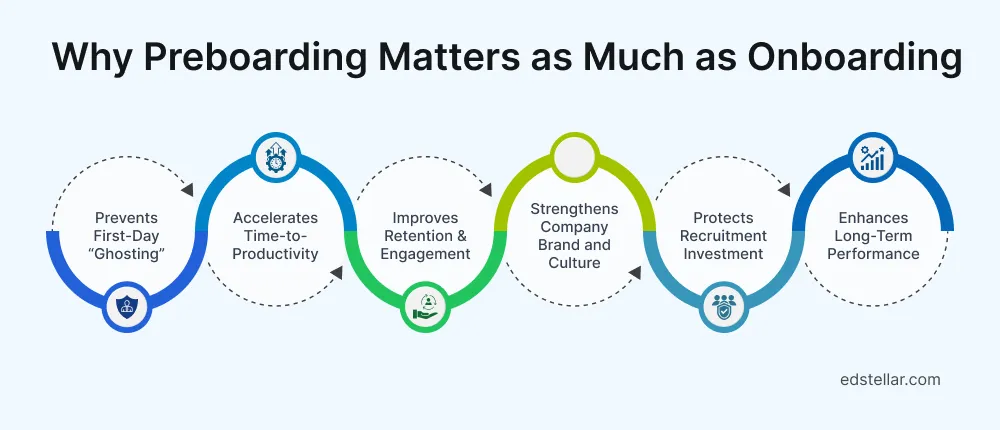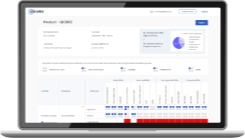
Preboarding and onboarding matter because they shape how employees first experience the organization. When the first steps are thoughtfully designed, it shows the organization is prepared and cares about setting employees up for success rather than leaving them to figure things out. Put simply, the first steps set the trajectory of the entire employee journey.
And the stakes are high. Organizations that align both stages see 82% higher retention, yet 64% of new hires say they receive no preboarding at all, and onboarding quality is often inconsistent.
The window to make an impression is also narrow: HR leaders have just 44 days on average to influence a new hire’s decision to stay long-term. Miss that, and the cost is steep. Employee turnover typically runs $7,500 to $28,000 per new hire.
Complicating things further, employees don’t all want the same experience. According to BambooHR, 30% of new hires prefer a slower, more gradual onboarding before taking on full responsibilities. For some, a fast track works. For others, being rushed only creates stress and second thoughts.
As Jay Samit puts it:
If senior leaders feel this disorientation, imagine how overwhelming it can be for a first-time hire.
This blog breaks down preboarding and onboarding as one continuous process. We’ll explore best practices, highlight key differences, and explain why preboarding matters just as much as onboarding. Along the way, we’ll share practical resources to help HR leaders and trainers design programs that work in the real world.
In short, you’ll see how to turn preboarding and onboarding into a seamless journey that welcomes employees, accelerates their productivity, and strengthens long-term commitment.
What is Preboarding?
Preboarding refers to all the activities that happen after a candidate accepts an offer but before their first official day. In this phase, HR and hiring managers keep new hires engaged, answer their questions, and handle administrative logistics so that employees feel valued and prepared before day one. A typical definition is:
Preboarding is the stage that occurs after a candidate accepts and signs their employment offer, but before their official start date. It includes a series of communications and preparatory actions designed to equip them for their new position.
In practice, preboarding tasks often include:
- Welcome Communications: Sending a warm welcome email or letter, introducing company culture, and setting expectations (e.g., schedule, dress code).
- Administrative Paperwork: Completing all necessary forms (tax documents, NDAs, policies, I-9, etc.) before Day 1. For instance, one preboarding checklist item is to send out any documents that new hires need to read and sign before officially becoming employees. This ensures Day 1 isn’t bogged down by paperwork.
- IT and Workspace Setup: Coordinating with IT and office teams to have the new hire’s computer, phone, email, building badge, and accounts ready. The new employee should find a desk area, hardware, and necessary software access already set up by their start date.
- Introductions: Assigning a “buddy” or peer mentor and facilitating initial meet-and-greets. Many companies use a “buddy system” to introduce the new hire to their team or a peer before Day 1. This can be as simple as an email introduction or a quick video chat. It helps new hires feel connected and reduces first-day jitters.
- Training Materials: Providing preliminary training or orientation materials online. For example, a quick video about the company, culture, or a first-day agenda can be shared in advance. This might include a link to an e-learning module or the employee handbook.
When these tasks are completed during preboarding, HR can ensure the new employee’s first day is devoted to engagement rather than paperwork.
Indeed, AIHR notes that scheduling these activities early makes new hires feel welcomed, informed, and prepared even before their first day. Crucially, skipping preboarding has real consequences: a CNBC study found that 1 in 5 new hires who accept an offer never show up on Day 1.
Often, these “ghost” hires have accepted a competitor’s offer, presumably because that competitor engaged them during the preboarding window. By contrast, keeping candidates excited and informed before they join can lock in those hires.
In short, preboarding is all about setting up the new hire for success from the moment they say “yes.”
A strong preboarding program improves retention (by as much as 82%) and makes the subsequent onboarding process smoother. For example, one HR study found that effective preboarding communications boost the overall onboarding experience by 83%.
The table below summarizes the main preboarding activities and benefits:
Together, these steps, summarized from industry best practices, help new hires arrive fully equipped and excited.
Good preboarding shows new employees that you value them as individuals, respect their time, and are committed to setting them up for success, fostering trust and loyalty before they even walk through the door.
In the next section, we’ll see how onboarding builds on this foundation.
What is Onboarding?
Onboarding begins on the employee’s first day (and continues for weeks or months afterward) and covers the formal processes to integrate new hires into their role and the organization. A common definition is:
Onboarding involves integrating new hires into the company and their position once they begin working.
In practice, onboarding is the structured program that turns a freshly hired candidate into a productive, engaged employee. It typically includes:
- Orientation: Introductions to the company, culture, and values. This often means a day-one orientation session on mission, policies, and organizational structure. For example, orientation might feature presentations about the company’s vision or tours of facilities.
- Training: Job-specific training to get the employee up to speed on their duties. This includes technical training on software/tools, as well as role responsibilities. (For example, if someone is in sales, onboarding might include product demos and CRM training.)
- Mentorship and Check-ins: Assigning a mentor or coach to guide the employee through the first months. Regular one-on-one check-ins with the manager ensure questions get answered and progress is tracked.
- Goal Setting: Defining short-term performance goals (often a 30-60-90 day plan) so the new hire knows what success looks like. Many companies encourage managers to jointly draft a 30-60-90-day plan to align expectations.
- Cultural Integration: Encouraging social connections and cultural fit. This can include inviting new hires to team lunches, social events, or peer-mentoring groups. New employees must understand how they fit into the company’s broader mission and values, making them feel part of the team.
An effective onboarding process is not a single event but an ongoing journey. Onboarding should last at least 3–6 months to fully embed new hires.
The benefits of a well-designed onboarding program are well-documented. For example, companies with a structured onboarding experience have 44% higher new-hire retention and 61% higher engagement.
Effective onboarding can improve retention. In contrast, neglecting onboarding is costly as replacing a departing employee can cost up to 200% of their annual salary. In other words, a bad onboarding experience can cost a company more than the hire’s entire compensation.
Good onboarding also pays off in employee attitude. Employees with effective onboarding feel engaged at work, compared to much lower engagement for those with weak programs. Only about 12% of employees rate their onboarding experience as very effective, suggesting most companies have room for improvement.
In summary, onboarding is the comprehensive process of welcoming and training a new employee after Day 1. It covers everything from orientation and role training to team-building and goal-setting.
By contrast with preboarding (which happens before Day 1), onboarding kicks in once the employee starts and continues until they are fully productive. Taken together, preboarding and onboarding form a continuous journey, from offer acceptance through the first months, that shapes a new hire’s experience.
Key Differences Between Preboarding and Onboarding
Both preboarding and onboarding are about preparing new employees, but they differ in timing, focus, and activities. The table below summarizes the main distinctions:

Broadly speaking, preboarding is about preparation and excitement, while onboarding is about learning and productivity.
In preboarding, a new hire might interact with the company for the first time (for example, via a welcome email or introductory video), whereas onboarding involves deeper integration into the team’s daily work. For instance, preboarding can involve meeting a future “buddy” or co-worker before Day 1, whereas onboarding might include shadowing that buddy on the job after joining.
Each phase has its leader: HR or recruiting usually handles the preboarding communications and paperwork, while the hiring manager and the team often drive the onboarding training and socialization.
Importantly, both stages should align. A new hire should feel continuity: what they learned or experienced in preboarding (e.g., company values, tools) should flow naturally into the Day 1 agenda and beyond.
Finally, the impact on retention and engagement can differ. By the time Day 1 arrives, preboarding success can already be measured by how many hires actually show up. Onboarding is then measured by how engaged and effective they become. For example, only a small percentage of employees say their onboarding was very effective, which implies most companies could do more in the early days.
The stakes are high: BambooHR research warns turnover in the first year is “HR’s responsibility,” meaning both preboarding and onboarding fall squarely on HR’s and management’s plates.
Why Preboarding Matters as Much as Onboarding
Too often, companies focus only on Day 1 and beyond, but neglecting the preboarding period can lead to lost talent and wasted resources. Many experts argue that preboarding is just as important as onboarding. Here are some key reasons:

- Prevents First-Day "Ghosting": Studies show up to 20% of new hires ghost their employer before day one if not properly engaged. These candidates may be swayed by competitors or second thoughts. A thoughtful preboarding process, including timely communications and personal engagement, dramatically reduces this risk.
- Accelerates Time-to-Productivity: Preboarding jump-starts learning. New hires who have filled out paperwork, set up their accounts, and reviewed initial materials can hit the ground running. Google famously implemented simple “nudges” (just-in-time reminders for managers) before a new hire’s first day, and saw those employees reach full productivity 25% faster. That equates to getting a month’s worth of work done in the first month alone! This example underscores that small preboarding steps (like manager checklists) can pay huge dividends.
- Improves Retention & Engagement: Data suggest that effective preboarding compounds the benefits of onboarding. A strong preboarding process leads to retention gains, and proactive preboarding makes the subsequent onboarding experience better. Happy, engaged new hires are far less likely to quit. Conversely, if new employees start their first day confused or left to fend for themselves (e.g., wading through incomplete paperwork or not knowing where to sit), their motivation and loyalty can plummet.
- Strengthens Company Brand and Culture: The preboarding period is a chance to showcase company values and build excitement. For example, some companies send welcome kits or personalized videos during preboarding, signaling “we’re excited for you to join.” Such gestures make new employees feel valued before they even join. It also sets cultural expectations early.
McKinsey notes that personalized digital recruiting journeys (aided by AI) can create a seamless onboarding that reflects company culture from the outset. When candidates see a well-organized process from the start, they view the company as professional and people-focused.
- Protects Recruitment Investment: Preboarding helps ensure you retain the talent you spent so much to attract. Across industries, hiring costs are high: SHRM reports an average cost per hire of about $4,700 (often far higher when including all recruiting expenses). For U.S. businesses, total training and onboarding expenses exceed $100 billion per year.
Failing to engage a hire pre-boarding risks scrapping that investment if they walk away. In the words of HR leaders: Turnover in the first 12 months is HR’s responsibility. Preboarding is an insurance policy – it “protects” the hire you’ve already won over with an offer.
- Enhances Long-Term Performance: Ultimately, the goal of onboarding is to develop high-performing employees. Preboarding sets the tone. Employees who go through a smooth transition are more confident and committed. That kind of lift means fewer disruptions, better team continuity, and more collective knowledge retained. On the flip side, poor preboarding/onboarding often results in a revolving door: two out of five employees are thinking about leaving in the next three to six months. If their onboarding is ineffective (meaning the employer repeatedly incurs recruitment costs).
In summary, preboarding matters because it is the prologue to onboarding. It ensures new employees arrive prepared, engaged, and aligned with company goals. Making hires feel valued early significantly reduces turnover. To illustrate, consider this checklist of preboarding benefits:
- Reduces No-Shows: Engaging hires promptly slashes the ~20% ghosting rate.
- Boosts Retention: A good preboarding regime can increase the chance that new hires stay long-term.
- Saves Time: Google’s case showed 25% faster productivity with timely preboarding nudges.
- Builds Enthusiasm: Early touches (welcome emails, executive videos, etc.) create excitement so that the employee’s narrative with the company starts positively.
- Saves Money: Every engaged hire is a win on that $4,700 investment. By preventing attrition, preboarding saves up to hundreds of thousands in potential replacement costs.
Given these gains, leading companies treat preboarding with the same rigor as Day 1 orientation.
Conclusion
Preboarding and onboarding are critical phases of the new hire journey. Preboarding, between offer acceptance and Day 1, focuses on engagement and preparation, while onboarding, starting on Day 1, centers on role integration and cultural immersion. Together, they shape a new employee’s experience, influence early productivity, and impact long-term retention.
Skipping preboarding risks disengagement, while structured programs improve retention and performance. Companies like Google demonstrate that even small preboarding improvements can accelerate time-to-productivity.
For HR and training professionals, key actions include: designing a preboarding plan with welcome messages, administrative setup, team introductions, and early training; formalizing onboarding with orientation, mentoring, and feedback; and tracking metrics like offer-to-join rates, time-to-productivity, and 90-day retention.
Investing in external training can enhance these efforts. Edstellar offers corporate human resource training programs, including our HR Excellence Program, which helps organizations build robust onboarding practices. As a global, instructor-led training platform, Edstellar delivers 2,000+ tailored programs across HR, leadership, compliance, and technical fields. It supports scalable upskilling with flexible on-site and virtual delivery, backed by 5,000+ verified trainers.
Key features include Skill Management Software, competency tracking via Skill Matrix, and options for trainers to join the network. Scheduling a demo allows tailored planning for skill transformation.
In sum, combining strategic preboarding, structured onboarding, and professional training turns onboarding into a competitive advantage. By nurturing talent from day zero, organizations boost engagement, performance, and retention, ensuring new hires become productive, committed team members.
Explore High-impact instructor-led training for your teams.
#On-site #Virtual #GroupTraining #Customized

Bridge the Gap Between Learning & Performance
Turn Your Training Programs Into Revenue Drivers.
Schedule a ConsultationEdstellar Training Catalog
Explore 2000+ industry ready instructor-led training programs.

Coaching that Unlocks Potential
Create dynamic leaders and cohesive teams. Learn more now!


Want to evaluate your team’s skill gaps?
Do a quick Skill gap analysis with Edstellar’s Free Skill Matrix tool

Transform Your L&D Strategy Today
Unlock premium resources, tools, and frameworks designed for HR and learning professionals. Our L&D Hub gives you everything needed to elevate your organization's training approach.
Access L&D Hub Resources.svg)
.svg)



.svg)



.svg)
.svg)
.svg)
.svg)

